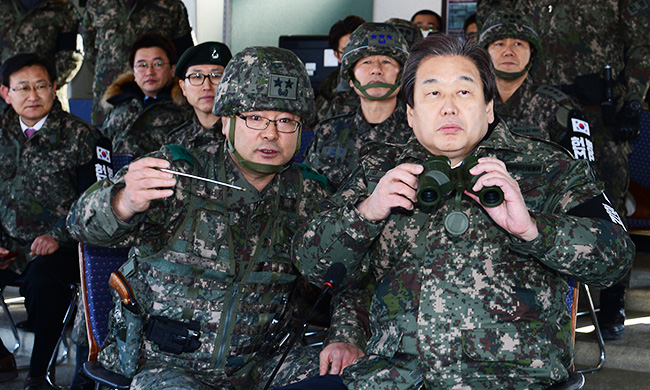- California Assembly OKs highest minimum wage in nation
- S. Korea unveils first graphic cigarette warnings
- US joins with South Korea, Japan in bid to deter North Korea
- LPGA golfer Chun In-gee finally back in action
- S. Korea won’t be top seed in final World Cup qualification round
- US men’s soccer misses 2nd straight Olympics
- US back on track in qualifying with 4-0 win over Guatemala
- High-intensity workout injuries spawn cottage industry
- CDC expands range of Zika mosquitoes into parts of Northeast
- Who knew? ‘The Walking Dead’ is helping families connect
Ruling party chief backs THAAD

Saenuri Party Chairman Kim Moo-sung, right, listens to the commander of the 6th Infantry Division during his visit to a general post near the border in Cheorwon County, Monday. (Joint press corps)
By Kang Seung-woo
Ruling Saenuri Party Chairman Kim Moo-sung said Monday that South Korea should positively consider accepting the deployment of the terminal high altitude are defense (THAAD) system on the Korean Peninsula, citing North Korea’s nuclear threats.
It is the first time for the ruling party leader to openly support bringing THAAD into the country that is creating controversy due to China’s adamant opposition to its presence on Korean soil.
In the wake of North Korea’s fourth nuclear test on Jan. 6, Seoul and Washington are about to begin formal discussions on THAAD, which is designed to destroy ballistic missiles ― particularly nuclear ones ― during their terminal phase.
“The North Korean nuclear test showed the dangerous behavior of the North Korean regime, so it is little wonder that we are discussing THAAD deployment to better protect us,” Kim said during a party Supreme Council meeting at the National Assembly.
“The North Korean nuclear program is an overriding issue that can determine the future of the nation, so we should neither passively react to the threats nor take account of international interests and concerns too much.”
“It is high time for South Korea to have a forward-looking and aggressive stance about the deployment of a THAAD battery,” Kim said.
Later in the day, the defense ministry said that it can jointly operate THAAD and L-SAM, South Korea’s own missile defense system, which could help the nation form a multilayer defense against the North’s nuclear and missile threats.
South Korea is developing its own equivalent of THAAD called L-SAM, or long-range surface-to-air missile that is expected to enter service in early 2020.
“As we see L-SAM and THAAD as different systems, coordinating them will help boost our national security and defense if we can do so,” said Moon Sang-gyun, the new spokesman at the defense ministry, in a briefing.
His remark reveals the Korean government’s apparent shift on THAAD.
Last March, when the issue was sweeping the nation, the ministry said that it will set up its own missile defense system based on the development of L-SAM and M-SAM, or mid-range surface-to-air missiles instead of bringing THAAD here.
However, the spokesman said that there has been no request made by the U.S. to open discussions on THAAD although talks are held inside the U.S. government.
Korea has quickly been leaning toward deploying THAAD here after President Park Geun-hye said during the New Year’s press conference, Jan. 13, that she would review introducing the missile interceptor here. This was followed by Defense Minster Han Min-koo’s Jan. 25 media interview underscoring the need for THAAD.
Rep. Chung Doo-un, the head of the National Assembly National Defense Committee, also said last week that it was time to open discussions on THAAD deployment here.
Since late 2013, THAAD has been a hot-button defense issue amid growing threats from the North, but the South had kept mum on it due to China’s strong opposition to its presence, claiming that it could be a threat to Beijing’s security. China is the South’s biggest trading partner.
The government move toward allowing the U.S. military to set up THAAD batteries follows China’s reluctance to press the North over its fourth nuclear test.















